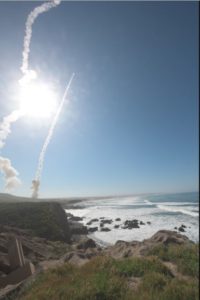The commander of U.S. Northern Command (NORTHCOM) on Thursday said he believes current U.S. missile defense systems can still defend against North Korean nuclear missiles amid a new test launch, but it is “crucial” the Next Generation Interceptor (NGI) is finished on time or early.
Earlier on Thursday, North Korea test launched what may be its largest intercontinental ballistic missile (ICBM), the road-mobile Hwasong-17. This was the first long-range missile test since a self-imposed moratorium in 2018. Like many previous long-range missiles it was launched in a lofted angle, reaching 3,850 miles. If launched in a normal trajectory toward the U.S., that would reach the American East Coast and it may be designed to carry several warheads at once.
During a hearing before the Senate Armed Service Committee, Chairman Jack Reed (D-R.I.) asked commander of U.S. Northern Command Air Force Gen. Glen VanHerck what he thinks of U.S. missile defense capabilities given this test launch.
“I’m comfortable with where we are today based on the intelligence I have with the current capabilities and capacity of North Korea,” VanHerck said.

However, “going forward, I do believe that they could exceed my capacity and capabilities. That’s why it’s crucial to keep the Next Generation Interceptor on time or early. In my discussions with [Missile Defense Agency director] Adm. Hill, he’s confident right now that they’re on that path,” he added.
The U.S. has 44 Ground-Based Interceptors (GBIs), largely based at Fort Greely, Alaska for the Ground-based Midcourse Defense system that aims to intercept small numbers of missile, like those from North Korea.
Last year, MDA selected two teams led by Northrop Grumman [NOC] and Lockheed Martin [LMT] to conduct initial technology development and risk reduction work for the NGI. MDA is developing the NGI to improve and replace the current GBIs (Defense Daily, March 23).
MDA initially plans to procure 20 NGIs that will feature both a new booster and kill vehicle. The agency previously said it plans to field the GBIs from fiscal year 2028 to 2030.
Reed asked VenHerck how confident he is that the GBIs are still on track for deployment by 2028.
“That is correct and I’m confident that it is on track for that now or slightly early, based on what I’ve seen,” he responded.
The head of NORTHCOM also said any plans to increase past the current 44 interceptors is a policy decision and he expects any potential changes in upcoming reviews.
“As far as the total number of 44 interceptors, that’s a policy decision. I look forward to seeing the Missile Defense Review and the policy that it provides in guidance to me to get after the capacity and challenges that you allude to, sir,” he said, referencing questions if the current capabilities can defeat increasing North Korean capabilities.
In response to questions from Sen. Deb Fischer (R-Neb.), Vanherck said the U.S. needs to field the NGI “as soon as we can get there.”
“I’m confident the contract mechanism rewards fielding it faster and I’m glad it’s on track right now,” he said.
MDA structured the NGI contract to keep competition lasting deeper into the development process than usual, at least through the critical design review. That opens the possibility that MDA may decide to double the production line to both competitors after a single design is chosen.
VanHerck also thanked the committee for continuing to fund the Service Life Extension Program (SLEP) for the current GBIs. He linked it to maintaining his ability to pace the production capacity and capability the Defense Department assesses the North Koreans are developing.
“And that’s why Next Generation Interceptor is crucial as well, it will help both get after additional capacity problems and the capability problems.”
Last year, Hill said the SLEP work is helping to bridge the gap until the NGIs are ready. Under this SLEP, MDA is removing the oldest GBIs from their silos, assessing their systems, replacing one-shot devices, changing boosters, updating processes, and recording hardware-based assessments to further the stockpile reliability program (Defense Daily, May 19, 2021).